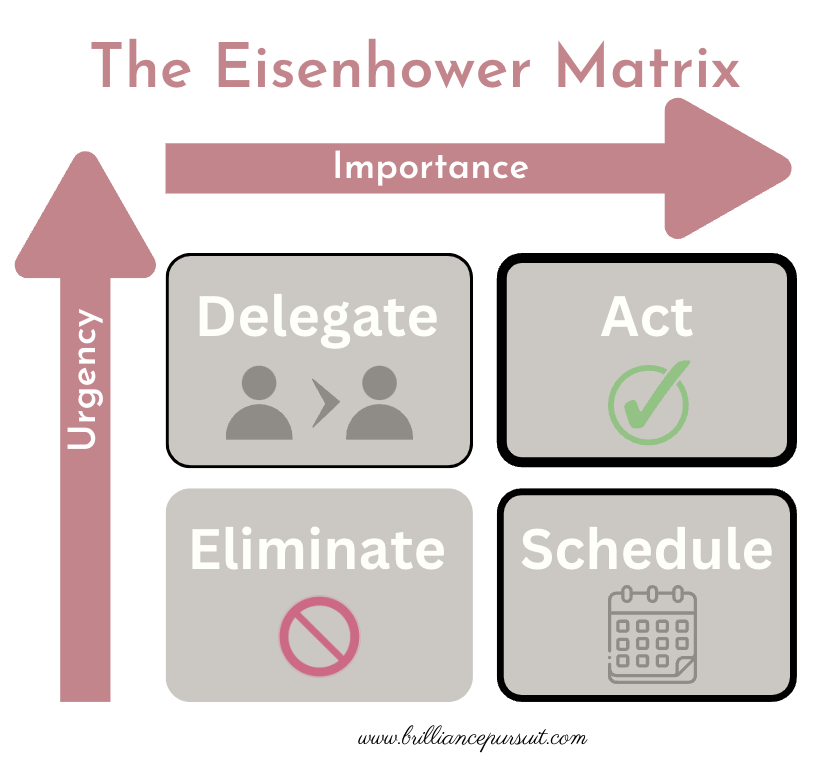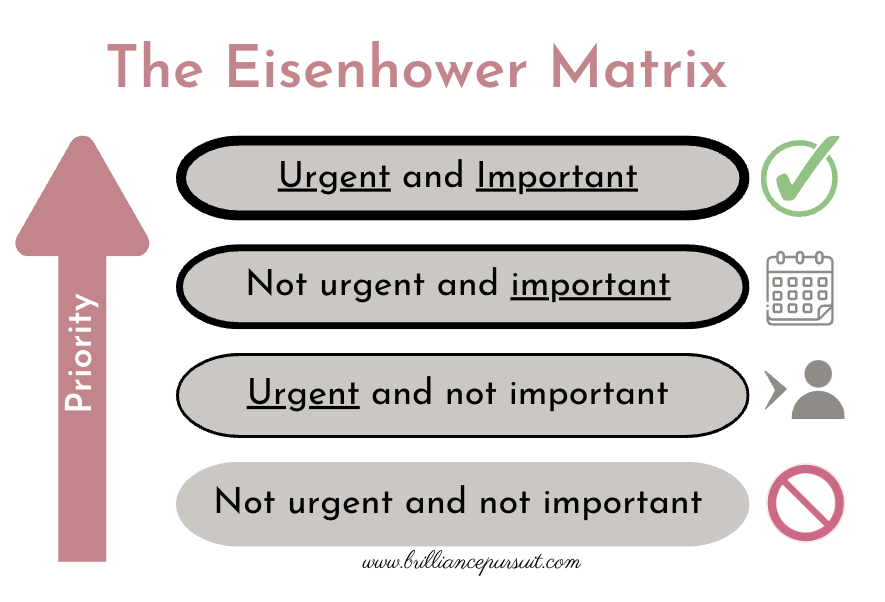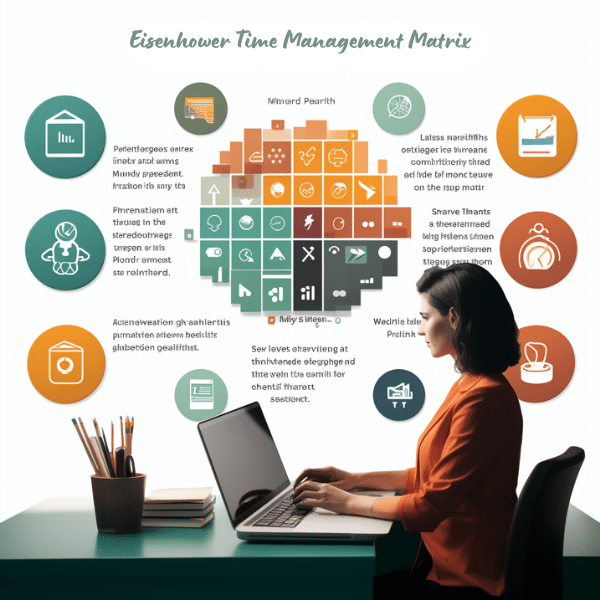Use the Eisenhower Time Management Matrix to Prioritize Better
Time is finite, but the demands on our time often seem infinite. The Eisenhower Matrix, or the Time Management Matrix is a simple yet powerful framework that helps prioritize tasks based on their urgency and importance. It helps you to prioritize your tasks and stay organized, focused on the tasks that really matter at the moment.
1. Definition of the Time Management Matrix used by President Eisenhower
“What is important is seldom urgent, and what is urgent is seldom important.”
U.S. President Dwight D. Eisenhower
This quote is believed to have originated during President Eisenhower’s tenure as the 34th President of the United States, which spanned from 1953 to 1961. The quote gained popularity in the context of time management and productivity, and it has since been associated with the Eisenhower Matrix.
The Time Management Matrix provides a simple yet effective framework to help individuals prioritize tasks based on urgency and importance. This tactical tool enables you to prioritize tasks based on their true value and impact, ensuring that you invest your time wisely and focus on what truly matters.

By understanding the Eisenhower Matrix, you can identify which tasks require immediate attention and which can be delegated, scheduled, or eliminated.
Key Takeaways of the Eisenhower Matrix:
- It was popularized by former US President Dwight D. Eisenhower
- The Time Management Matrix is a framework for prioritizing tasks
- The matrix divides tasks into four categories:
- Quadrant 1: Important and urgent → Act
- Quadrant 2: Important but not urgent → Schedule
- Quadrant 3: Urgent but not important → Delegate
- Quadrant 4: Not important and not urgent → Eliminate
2. The 4 different Categories of the Eisenhower Time Management Matrix
2.1. Time Management Matrix – Category 1:
Important and Urgent Tasks → To Do: Act
When faced with tasks that fall into this category, it is crucial to tackle them promptly and efficiently. Prioritize these tasks based on their impact on your goals and immediate needs.
Start by assessing the situation, understanding the urgency and potential consequences. Break them down into manageable steps, create a clear action plan, and allocate the necessary resources to complete them effectively.
Stay focused and avoid distractions to ensure that these important and urgent tasks receive the attention they deserve.
2.2. Time Management Matrix – Category 2:
Important but Not Urgent Tasks → To Do: Schedule
Tasks in this category are often overlooked or pushed aside in favor of more immediate matters! However, it is essential to allocate time and attention to these tasks, as they contribute to your long-term success and personal growth.
Schedule dedicated time for these activities, whether it’s skill development, strategic planning, or relationship-building. Create a proactive approach by setting specific goals and deadlines for these tasks, allowing you to make consistent progress.
Remember, investing in important but not urgent tasks can prevent future crises and pave the way for meaningful achievements.
2.3. Time Management Matrix – Category 3:
Urgent but Not Important Tasks → To Do: Delegate
While these tasks may create a sense of urgency, it’s important to evaluate their true importance and impact on your goals. If the task is truly not important but must be done anyhow, consider delegating or finding alternative solutions to address it efficiently (see 3.)
Start by assessing whether the task aligns with your priorities and contributes to your desired outcomes. Learn to say no to tasks that don’t align with your objectives, and avoid getting caught up in unnecessary distractions.
Evaluate their importance, focus on maintaining boundaries, and redirect your energy toward tasks that truly matter.
2.4. Time Management Matrix – Category 4:
Neither Important nor Urgent Tasks → To Do: Eliminate
Tasks in this category offer little to no value in terms of your goals and priorities. It’s crucial to minimize or eliminate these time-wasting activities to free up more valuable time and energy.
Consider setting boundaries, implementing digital detoxes, or finding alternative activities that bring more value and fulfillment to your life.
Redirect your attention towards tasks that align with your aspirations and contribute to your overall well-being.
Identify, minimize, and eliminate unnecessary time-wasters in your routine, such as excessive social media scrolling or unproductive habits, and make a conscious effort to reduce or eliminate them.
Call to action: Take a moment to assess your current workload and identify tasks that fall into each quadrant of the Time Management Matrix. This exercise will provide clarity on where you’re spending most of your time and help you recognize areas for improvement.

Additional ideas on how to handle Category 3 – Delegation, if you don’t have anyone to delegate to:
However, it would be nice to delegate urgent yet unimportant tasks (from quadrant 3) to somebody else; unfortunately, not everybody has someone to delegate stuff to.
So, here are some other strategies to try out when handling tasks in Quadrant 3:
Batch tasks: Group similar low-priority tasks together and tackle them in a single session. This approach allows you to maintain focus and efficiency while minimizing the time and energy spent on less important activities.
Set time limits: Allocate specific time blocks for these tasks to avoid them consuming more time than necessary. By setting time limits, you create a sense of urgency and prevent these tasks from encroaching on more important activities.
Delegate to technology: Leverage technology tools and software to automate or streamline these tasks as much as possible. For instance, using email filters or automation tools to organize and categorize emails can help reduce time spent on low-priority messages.
Consider alternative solutions: Explore alternative approaches to handling these tasks. Is there a more efficient or streamlined way to achieve the same outcome? Can you simplify or eliminate certain steps? Be open to finding creative solutions that save time and effort.
Reevaluate necessity: Question the true necessity of these tasks. Are there any that can be eliminated or minimized without significant consequences? By critically evaluating their importance, you may discover that some tasks can be deprioritized or eliminated altogether.
Delegate to future self: If the task can be delayed or postponed without negative repercussions, consider delegating it to your future self. Schedule specific time slots in the future to tackle these tasks when you have more availability or when they become more time-sensitive.
Remember, the goal is to minimize the time and energy invested in low-priority tasks while ensuring they are still completed when necessary!
3. Benefits of the Eisenhower Time Management Matrix
Prioritization: The Eisenhower Matrix provides a clear framework for prioritizing tasks based on their importance and urgency. It helps individuals focus their time and energy on activities that align with their goals and have the most significant impact.
Time management: By categorizing tasks into quadrants, the matrix allows for effective time management. It helps individuals allocate their time more efficiently by distinguishing between tasks that require immediate attention and those that can be planned for later.
Improved decision-making: The matrix promotes better decision-making by forcing individuals to evaluate the importance and urgency of each task. It encourages a thoughtful approach to task management and reduces impulsive reactions to urgent but less important matters.
Increased productivity: By identifying and prioritizing important tasks, the matrix helps individuals stay focused on activities that contribute to their long-term success. It minimizes time wasted on low-priority tasks, resulting in increased productivity and the accomplishment of meaningful goals.
4. Flaws of the Eisenhower Time Management Matrix:
Lack of flexibility: The matrix relies on a rigid categorization of tasks into four quadrants. However, real-life situations often involve tasks that don’t neatly fit into one category. This lack of flexibility can limit the matrix’s applicability in complex or dynamic environments.
Neglect of non-task-related factors: The matrix primarily focuses on task prioritization and may overlook other factors that contribute to overall well-being and success, such as self-care, relationships, or personal development. Overemphasis on task management alone may lead to an imbalanced approach to life.
Overemphasis on urgency: The matrix gives significant weight to the urgency of tasks, potentially leading individuals to prioritize short-term, time-sensitive activities over important but less pressing long-term goals. This bias towards urgency may hinder strategic planning and personal growth.
The subjectivity of importance and urgency: Determining the importance and urgency of tasks can be subjective and vary from person to person. What may be considered important or urgent for one individual may not hold the same significance for another, leading to potential discrepancies in task classification.
Despite these limitations, the Eisenhower Matrix remains a valuable tool for many individuals seeking to improve their time management skills and prioritize effectively. It provides a framework that can be adapted and modified to suit individual needs and circumstances.
If you want to read more on how to improve your time management skills, read here.






